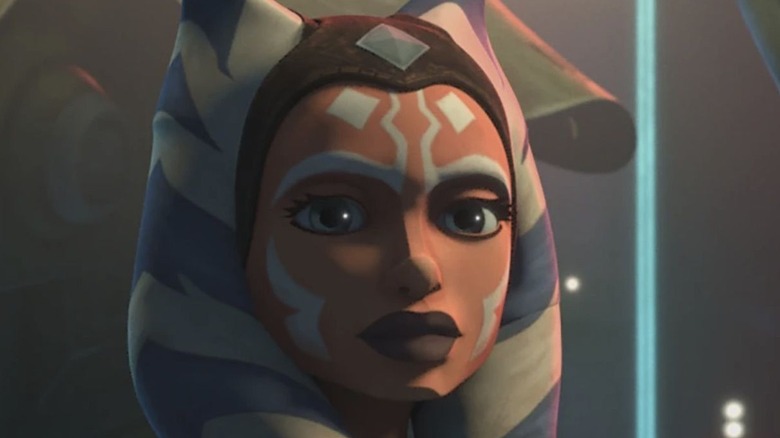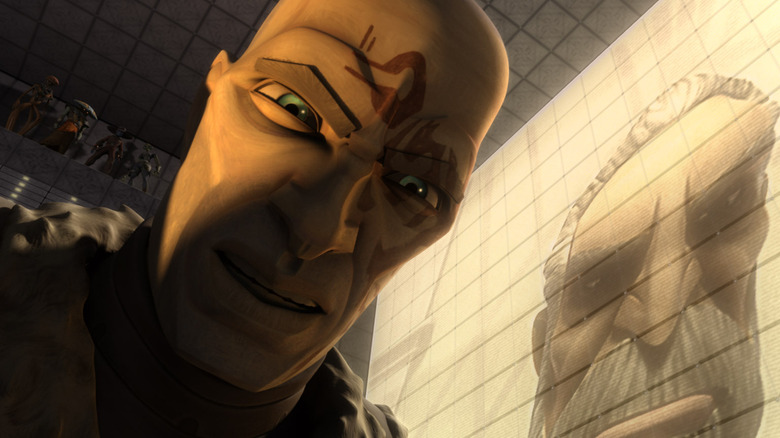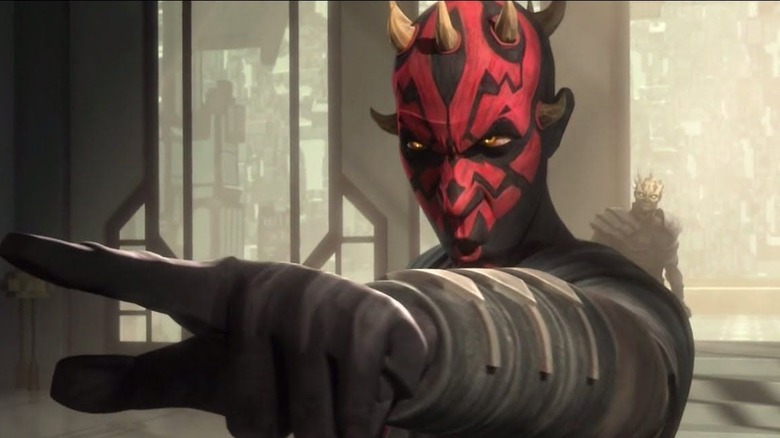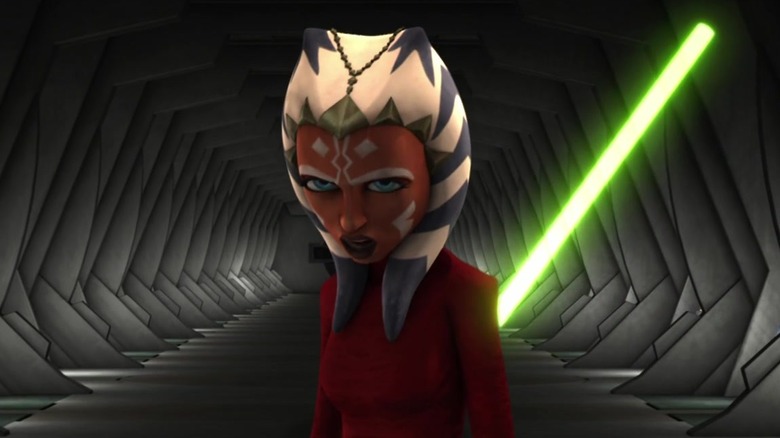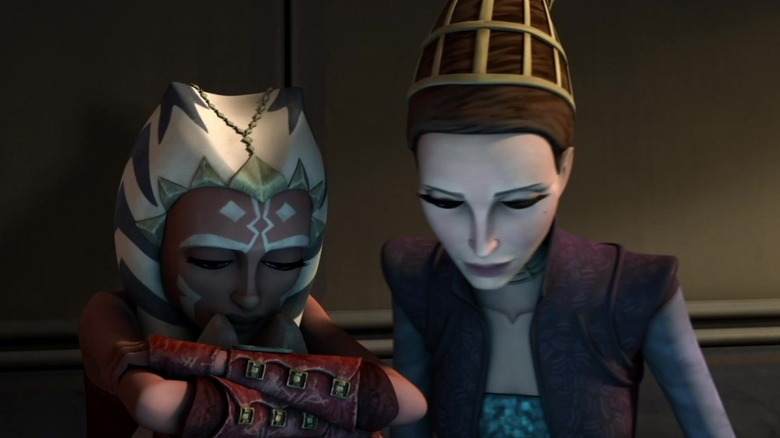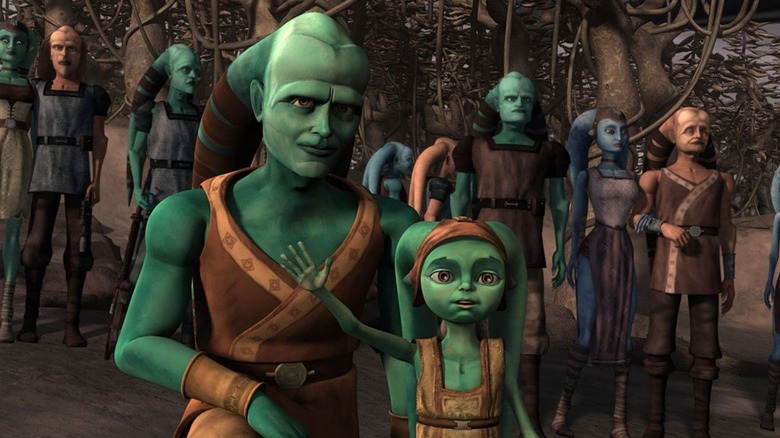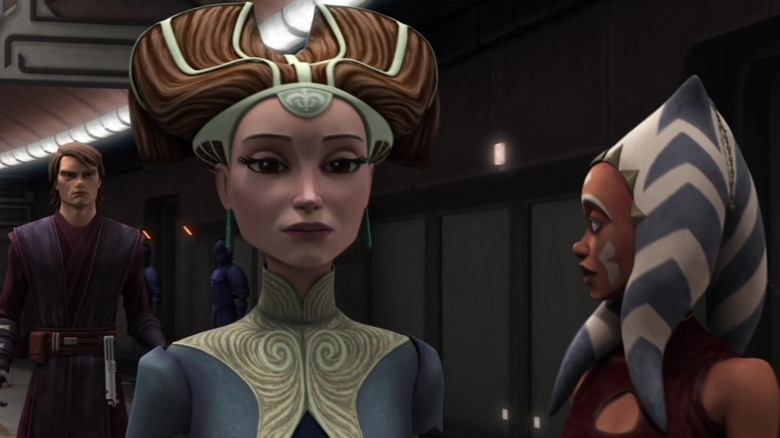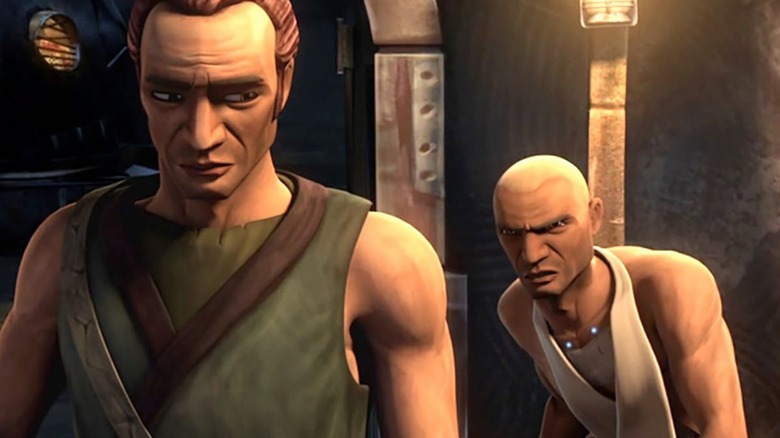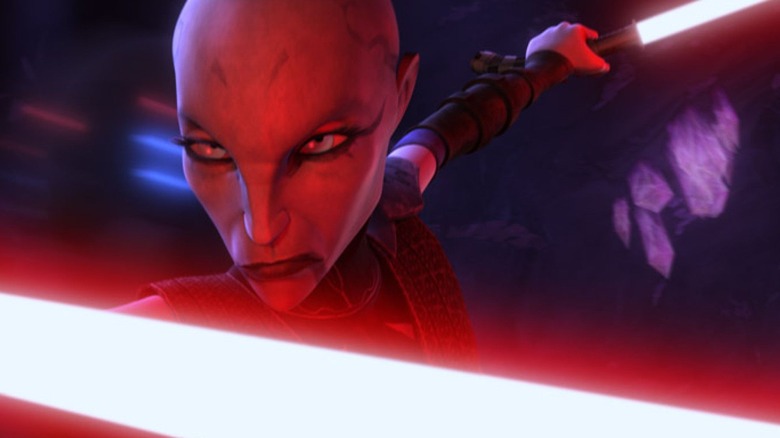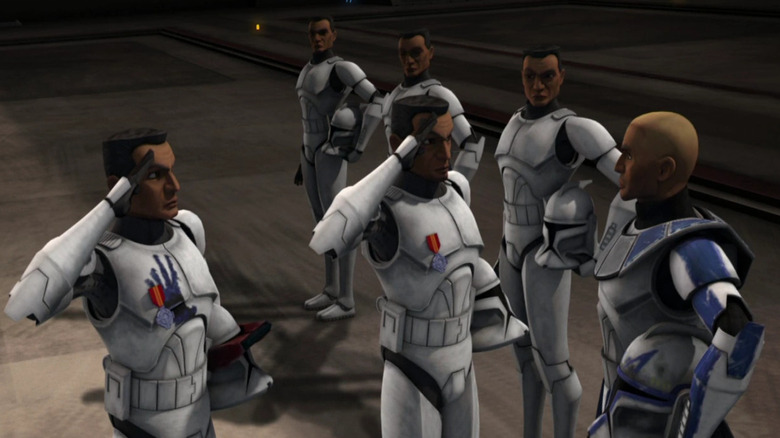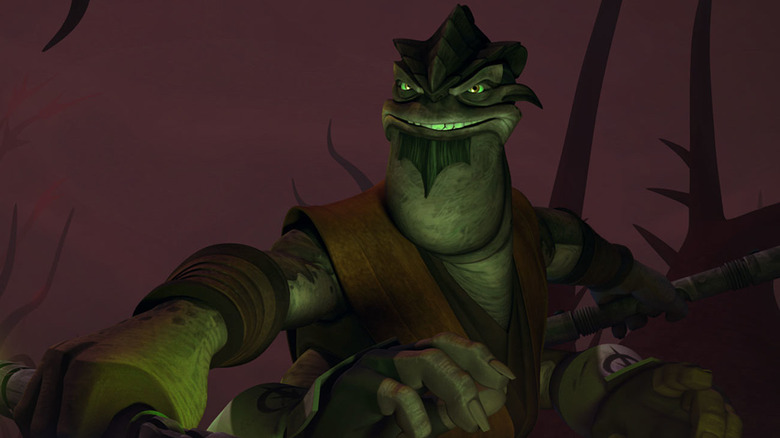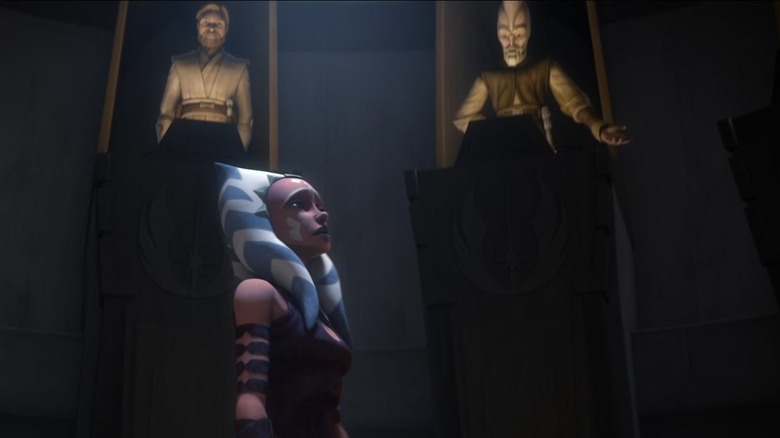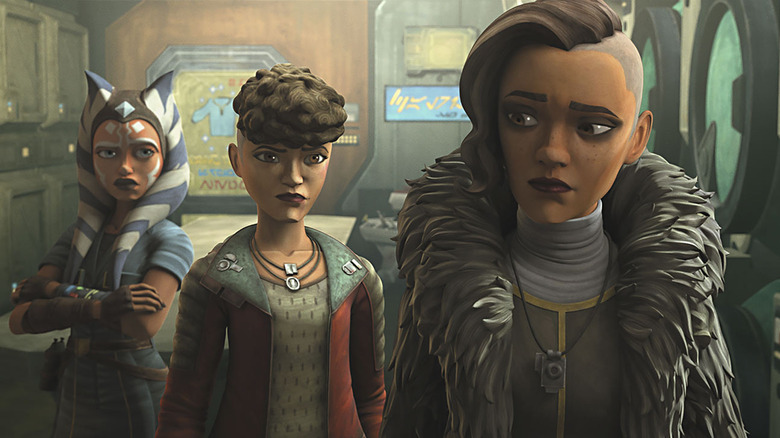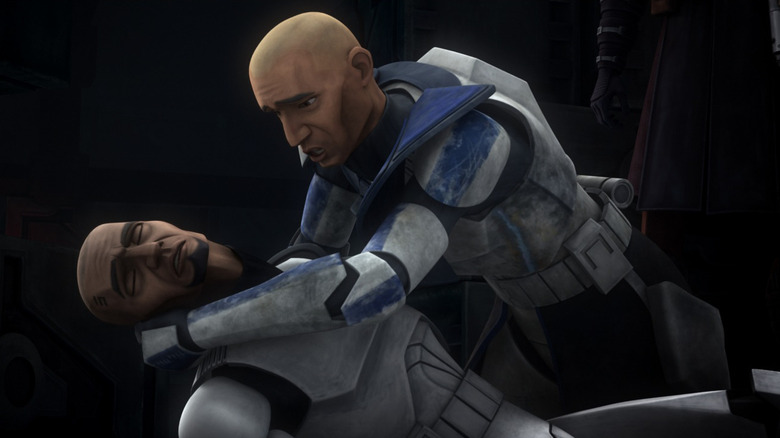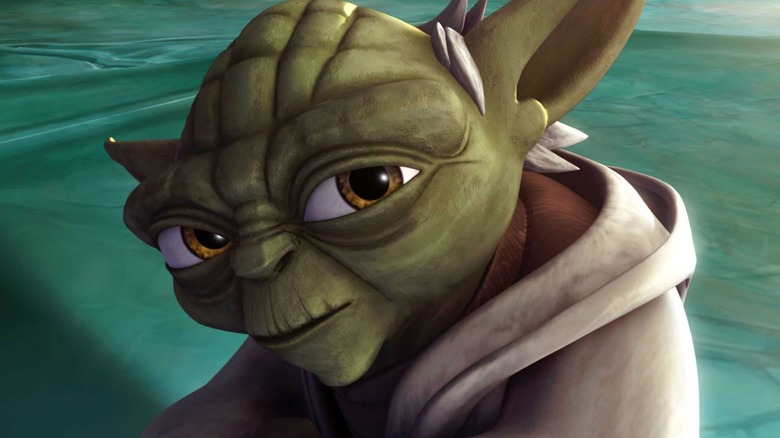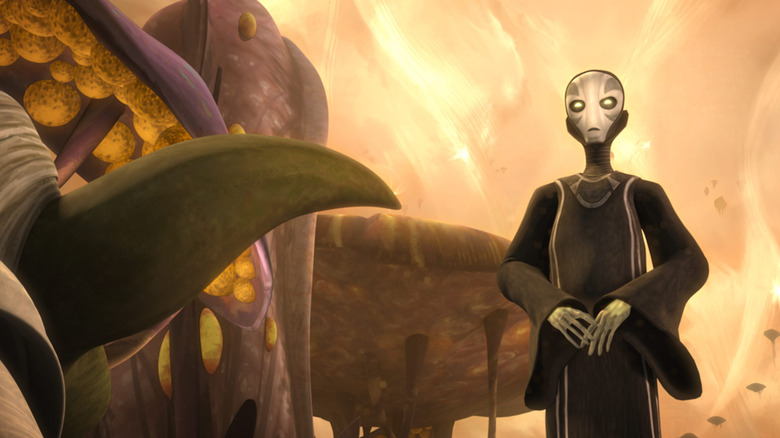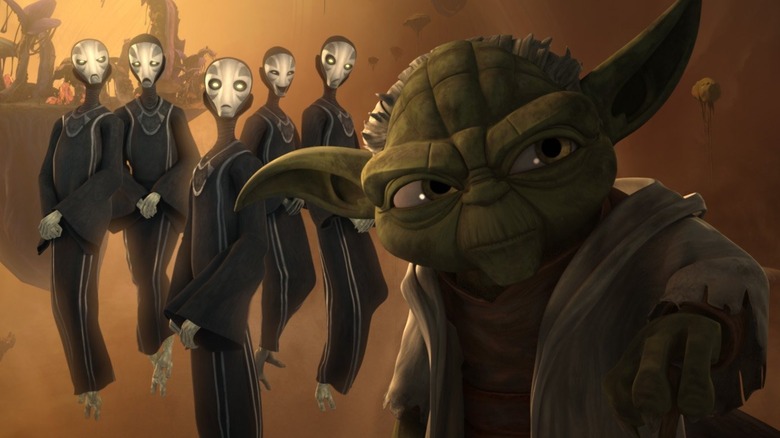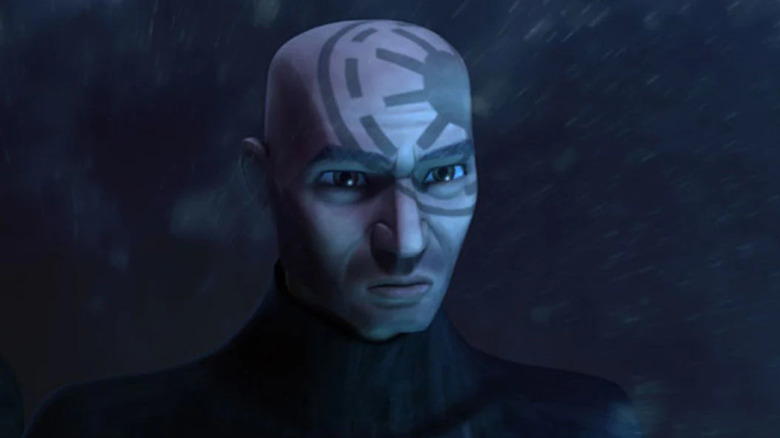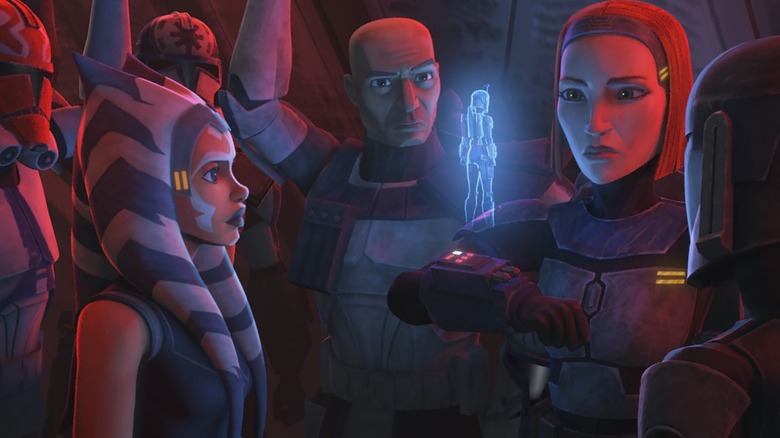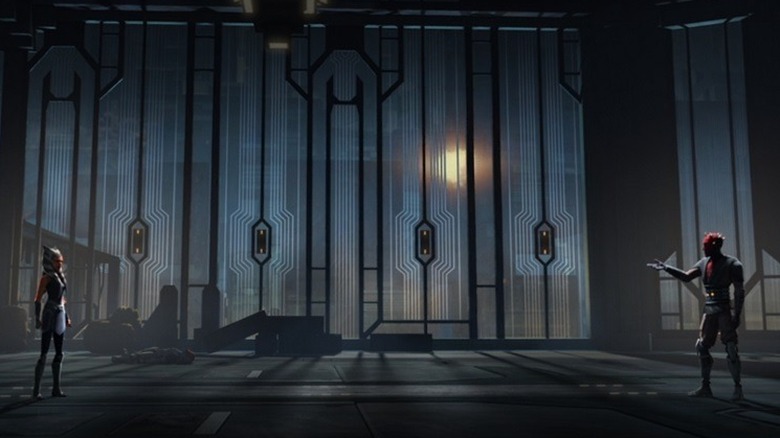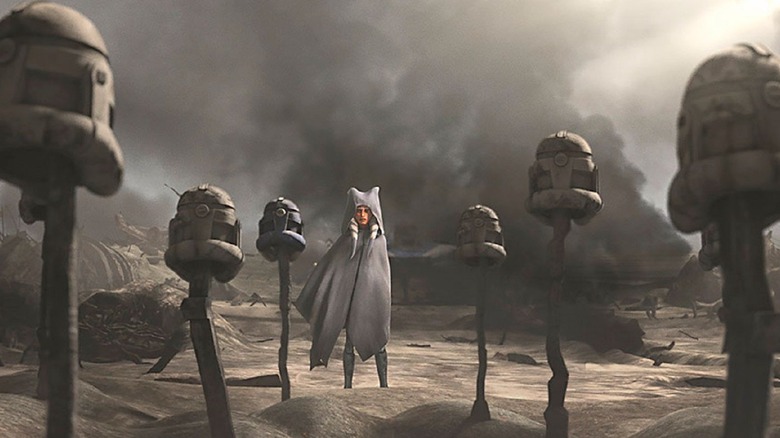The 20 Best Clone Wars Episodes Ranked
It took time for "Star Wars: The Clone Wars" to steady its launch. Impressed by Dave Filoni's directorial work on "Avatar: The Last Airbender," George Lucas hired him as supervising director at the developing Lucasfilm Animation studios for a CGI series that would expand the Star Wars universe. Working off the blueprints of "Samurai Jack" creator Genndy Tartartavosky's proto-canon 2D "Star Wars: Clone Wars" micro-series, "The Clone Wars" told stories in the three years between "Attack of the Clones" and "Revenge of the Sith." It starred classic characters — Anakin Skywalker, Obi-Kenobi, Padme, Yoda — while introducing more. This includes Anakin's apprentice, Ahsoka Tano, who never existed in the live-action films (she subsequently got a voice cameo in "Rise of Skywalker" and later became live-actionized in "The Mandalorian").
Clone Wars" debuted with a tepidly-received theatrical feature that had under-rendered visuals and cringe-worthy dialogue. But, as a television series airing on Cartoon Network, it found a better reception, earned Emmy and Annie awards nods, accumulated a dedicated fanbase, and saw the quality of its animation drastically improve. "The Clone Wars" met an untimely cancelation in 2014, but many of its characters resurfaced in the Original Trilogy-era animated series "Star Wars Rebels" before a revival season aired in 2020 on Disney+.
With 133 episodes spread across 7 seasons, "The Clone Wars" has the full range; some episodes are slogs, others are goods to great, and a few elevate galactic storytelling to cosmic resonance. While the "The Clone Wars" told stories in multiple-episode arcs, we're evaluating each one by its self-contained qualities. Clone soldiers questioning their command; Ahsoka's difficult education; villains and anti-villains prowling the galaxy; these are the greatest episodes of "The Clone Wars."
The Box
Directed by Brian Kalin O'Connell, "The Box" is the third part of an arc in which Obi-Wan fakes his death and goes undercover as a bounty hunter to foil a scheme to kidnap Chancellor Palpatine. The whole storyline was based on an entertainingly precarious scenario, exploiting the comedy of Obi-Wan inhabiting the role of a crude-talking bounty hunter while pushing the Jedi into situations where his mercy could give him away to his bounty hunter allies. Obi-Wan's staged death also amplified Anakin Skywalker's distrust in the Jedi ways.
But the most enthralling part of the arc is "The Box," which shoves Obi-Wan and the bounty hunters through a gauntlet of death traps. Inspired by the 1997 movie "The Cube," the episode features bounty hunters auditioning for the right to kidnap Chancellor Palpatine. As failed contestants plummet into the fire pit or end up sliced by laser traps, the pressure builds as Obi-Wan tests his sniping abilities and his wits, while also preserving his moral code and assisting other bounty hunters. "Clone Wars" characters frequently use their smarts in addition to their powers, but rarely face purely puzzle-driven trials like this one. You've gotta give the villainous architect credit for his creativity.
Shades of Reason
When George Lucas instructed "The Clone Wars" executive producer Dave Filoni to revive the legendary prequel villain Darth Maul, played physically by Ray Park in the 1999 "The Phantom Menace," Filoni had some questions. How were Filoni and the creatives going to revive Maul? How do you bring back a dead villain who was bisected by Obi-Wan Kenobi's lightsaber and fell into a bottomless pit?
"I don't know, you'll figure it out," Lucas allegedly said. He was right. In the episode "Brothers," a Force-sensitive Zabrak named Savage Opress finds Maul still alive, his lower-half replaced with metallic spider-legs. Yes, this is a silly twist, even by Star Wars standards, but the ensuing mayhem pays off in dividends, adding an awesome foe to terrorize the galaxy and throwing a wild card into the Jedi's plans. After setbacks, "Shades of Reason" sees Maul's plotting reach its peak, as the one-time Sith exploits alliances and traditions to claim Mandalore's throne for himself, breaking Obi-Wan's spirit.
Giving Maul a speaking part could've drained the former Sith of the mystique Park physically embodied, but voice actor Sam Witwer's performance oozes with vulnerability and malicious conviction. Beyond the fan-pleasing cool factor of seeing Maul kick butt while ramping up the stakes (and duel his former master, Darth Sidious), Witwer makes Maul into a tragic figure whose fate might have been very different if he hadn't fallen under Sidious's influence.
Cargo of Doom
"Cargo of Doom" continues the Jedi's chase after the hyper-competent Cad Bane, a bounty hunter with a John Wayne swagger who's a formidable opponent for any Jedi. In "Cargo of Doom," Ahsoka and Anakin are scurrying to capture Bane and retrieve a stolen Jedi holocron, both of them threatening to fall victim to their own hubris. It's the episode that solidifies Ahsoka and Anakin as a charming teacher-student pair, each one complimenting the other's faults, competency, and good intentions in the midst of battle.
It also contains one of the defining moments of their relationship. When Ahsoka runs into Bane's trap and her teacher has to save her butt, the Padawan acts like every kid who knows they screwed up, pouting in her cell. And yet, after Anakin rescues her, he ends up breaking his own rules and runs off recklessly to catch the enemy. In response, Ahsoka turns the tables and screams "Patience, master!" using his own words against him. Realizing he would be a hypocrite if he didn't heed her words, Anakin defers. This illuminates the dynamic between Anakin and Ahsoka, their contradictions, and their bond. Anakin wants to be a good role model, but also continually slips into his maverick habits, while Ahsoka keeps his questionable impulses in check.
Assassin
Ahsoka undergoes a series of harrowing Force visions, in which she sees a bullet striking Senator Padme. Full of anxiety, Ahsoka warns Padme to avoid a humanitarian conference. But, as a leader, Padme is determined to attend. Together, the two coordinate security, working around Ahsoka's vision to guard Padme from her fate. Thus, the Padawan learns the hard way that visions are tricky and do not always show the entire picture. In the end, "Assassin" is less about catching the culprit and more about fleshing out Ahsoka's journey, which involves a sincere depiction of a teen stressing over change at a mystical level.
Ahsoka learns a lesson here, one that would have benefited Anakin and prevented tragedy by "Revenge of the Sith": Padme can take care of herself. Ahsoka's biggest accomplishment is that she strikes balance between being protective and trusting strong people to handle their fate. It's also a great Padme and Ahsoka bonding session, especially for two women bearing the weight of such huge responsibilities.
Innocents of Ryloth
The Republic army heads to the Separatist-occupied planet of Ryloth, home of the head-tailed Twi'lek race. Two clone soldiers, Waxer and Boil, are sent to meet up with Kenobi's force, but they run into a delay: a lonely, orphaned Twi'lek child named Numa. Trying to overcome the language barrier, the clones share a ration with the girl. As they bond, she sprouts a word unknown to them: "Nerra, Nerra." Turns out, Numa sees them as brothers.
Beyond the inherent cuteness of two grown guys interacting with a kid, "Innocents of Ryloth" emphasizes the price of war, providing the soldiers with a view of upended homes and their families. "Innocents of Ryloth" is also one of the few chapters of "The Clone Wars" in which non-Republic civilians are seen saving themselves without instructions from Republic figures. At the beginning, the clone soldiers view the Twi'lek civilians as passive "headtails," and obstructions to their tasks. But those civilians demonstrate their fortitude against oppression. We may not understand Numa's language, but we understand her bravery when she dashes into danger to help a Jedi to his feet, and her heroism inspires her Twi'lek compatriots to fight back against their captors.
Heroes on Both Sides
Circumventing Republic protocol, Senator Padme takes Ahsoka, a Jedi, to confer with a Separatist friend in a push for peace. Ahsoka is confused by Padme's friendship, both political and personal, with a Separatist, the Republic's sworn enemy. For the first time, Ahsoka meets Separatists who are not droids, not General Grievous, and not greedy officials. She learns there are people on the Separatist side who want to end the war as much as the Republic does, and realizes that, sometimes, the Republic imposes its will on unwilling systems.
"Heroes on Both Sides" is hardly the first "Clone Wars" to acknowledge the grey morality of war, but through Ahsoka's eyes, it becomes one of the sharper examinations. It also contains a timely commentary about political parties that use war to push their own financial interests. "I don't understand ... all anyone argued about was banking deregulation and interest rates," Ahsoka moans, discovering how complex war-time politics can be. The moral that politics sometimes do not fit easily into black and white boxes resonates with her throughout the remainder of the Clone Wars.
The Deserter
Wounded by the Separatist droids' army on Saleucami, clone Captain Rex is left to recuperate on a farm. There, he discovers that the farmer's husband has his face. Turns out, the homestead is run by a clone deserter, who has named himself Cut Lawquane. Cut fled the army and married a farmer, becoming a father to her two children. Rex is livid. Why would a soldier abandon their duty? It has to be explained to him: Cut never chose his lot in life, so he broke from military servitude and found himself a family. For Cut, duty is protecting his wife and kids.
Even as he rides back to the Republic, Rex learns that clones can find different purposes in life, and becomes Cut's secret keeper. In doing so, Rex realizes that sometimes he must circumvent orders in order to do the right thing. It's no wonder that "The Deserter" received a strong sequel of sorts in "The Bad Batch" episode "Cut and Run," in which Cut is used to illustrate different ways the clones may have dealt with the post-Republic era.
Bounty
The life of Asajj Ventress, the former Sith acolyte cast out by Count Dooku, is heavy with loss and betrayal. "Bounty" marks her growth. After losing her Nightsister witch community, Ventress drowns her sorrows on Tatooine. Then a vacancy in a bounty hunter group, led by a young Boba Fett, allows her to test her skills and reflect on her morals. She joins the crew to get creds in her pockets, but the journey also helps her formulate her principles.
The bounty hunters are assigned to guard a warlord's precious cargo, which is stored on board a running train. Soon, they're ambushed. But Asajj discovers that said cargo is a living being, a young girl, and that the raiders are the girl's family. The girl appeals to Ventress' conscience, and Asajj ends up sparing a young girl from bridal captivity — not without accepting payment for it, but still. For the first time, Asajj permits herself a smidge of empathy and realizes she has a future.
Asajj's growth is also paralleled by Boba's dark coming-of-age. Like Ventress, he's formulating his moral compass. Note the scene in "Bounty" in which he's baffled by the knowledge that their cargo turned out to be a living girl, and is so confused that he promises the girl protection — until she kicks back, that is, and he falls prey to petty dislike, revealing his idiosyncratic depth.
Rookies
"Is 'The Clone Wars' worth watching when you know that these characters will not have a pleasant end?" is a question worth asking. And then, along comes "Rookies" with the answer: yes. Yes, let's hang out with these clone brothers, who are compelling and human despite their role in executing Order 66, which wiped out the Jedi. As season 1 was figuring itself out, "Rookies" uncovered the heart of the series: the clones of said Clone Wars.
Season 1 promised to develop the clones' characters, and "Rookies" is the first time that pledge really paid off, giving the rookie clones the limelight and voice actor Dee Bradley Baker his first real showcase. Even though the clones all have similar voices, Baker makes sure they don't sound exactly the same. They're all different characters, even if they share the same face. The episode also contains the funniest "Clone Wars" gag: a droid attempts to robotically impersonate a clone, and Rex bites back by impersonating a droid. It's also an important episode, lore-wise. Two of the surviving clones, Fives and Echo, play consequential roles as the series goes on.
The General
Notable for being one of the two directorial credits belonging to Walter Murch, "Apocalypse Now" sound designer and a close friend of George Lucas, "The General" is a definitive "War is Hell" episode. Umbara was established as a nightmare landscape in the arc's first installment, and the second entry drenches you with griminess, introducing you to a tight-fisted Jedi leader who doesn't have the same compassion as Yoda or Anakin.
War was never comfortable, but the clone soldiers are exceptionally challenged while following brutal Jedi General Pong Krell. The clones debate the motives and efficiency of a Jedi who makes dubious military choices, most of which lead to growing a pile of casualties. Unlike Skywalker or Yoda, Krell looks upon the clones with disdain, tests their patience, and belittles their position. Rex permits two clones to shirk Krell's orders to steal valuable tech from the enemy.
In one of the series' best sequences, the individual clones vocalize their dissent, raise questions, and further discuss Krell's orders. Collective as they may be, textured scenes like this remind the viewers that the clone soldiers are beings with their own minds, own values, and own views of the world.
The Wrong Jedi
The last part of its arc, as well as the show's original series finale on Cartoon Network, "The Wrong Jedi" serves as one hell of a deconstruction of the Jedi Order. Ahsoka Tano is framed for bombing the Jedi Temple, and, influenced by Republic partisanship, the Jedi Council strips Ahsoka of her Padawan status instead of standing by her side. To clear her name, Anakin captures the true culprit: Barriss Offee, a disgruntled Jedi knight upset about the Jedi's involvement in the war. Although exonerated and offered back her braid, Ahsoka loses faith in the wisdom and goodwill of the Jedi. Despite Anakin's protests, she walks away from the temple as a civilian. For all of its sorrows, "The Wrong Jedi" is a befitting send-off for the character, allowing her to take charge of her spiritual needs instead of those of the politically-ensnared Jedi institution.
Ahsoka's departure marks a seismic shift in the status quo, and does something that Star Wars had never done before: show a Jedi resigning, providing a direct contrast to Anakin's fall to the dark side. This episode ends on a tearjerker, too: the infamous shot of Ahsoka slinking down the Jedi Temple steps into the sunset, walking into another phase of her life.
Gone with a Trace
This is the first episode checking in on Ahsoka after she resigned from the Jedi Order in "The Wrong Jedi." A motor malfunction causes her to fall into a pit, literally, in Coruscant's lower echelons, forcing Ahsoka to reside among the city's lower crust. She's quickly befriended by the not-so-bright but good-natured Trace, who's raised by her shady older sister, Rafa. "Gone with a Trace" illuminates the clash between Ahsoka' privileged Jedi education with the sisters' lack of money, means, or real power.
Trace and Rafa also turn out to be among the most idiosyncratic supporting players in "The Clone Wars," examples of civilians failed by the Republic and the Jedi. Before, we mostly saw civilian politics through the eyes of senators or other influential figures. Trace and Rafa, by comparison, are downtrodden and desperate. Trace suffers from a lack of education, while Rafa conducts questionable business in order to put food on the table. "Gone with a Trace" strikes a delicate balance, never excusing criminal behavior but remaining deeply empathetic towards its amoral survivors, ultimately echoing themes from the sequel-era cartoon, "Star Wars Resistance."
Orders
Why did clone trooper Tup shoot his Jedi General in the middle of a battle? Fives will find out. After some digging on Kamino, Fives discovers that Tup — and every other clone — has been implanted with brain chips. So, Fives gets his chip removed, surmising that the technology could put the soldiers in danger. As we know from "Revenge of the Sith," he's right; "Orders" leans heavily on dramatic irony. When the Jedi permit Fives an audience with Chancellor Palpatine, we know it will not end well. Whatever Palpatine said to Fives — or did to him — sends the clone scurrying out of Coruscant as a fugitive, raving with madness. He's treated as well as Troy treated Cassandra for its fall.
Outrage froths throughout "Orders," as does injustice. When Fives hails a hover-taxi to take a trip to a clone bar, the cabbie mentions, "I didn't know they had a bar." Fives also resentfully tells the cabbie to "bill [my taxi fare] to the Republic." Republic civilians don't imagine clones as capable of having dreams or pastimes, but they do. You wonder what could have been if these souls weren't bred for war.
At least Fives' dying words end up saving other clones, including Rex, who survives through "Rebels" and ends up fighting against the Empire on Endor. Still, the image of the clones removing their helmets, staring in sorrow and confusion at Fives' words, remains haunting.
Voices
This is the first installment in an arc in which Yoda hears voices from beyond. To his astonishment, Yoda discovers that the voice belongs to the spirit of slain Jedi Master Qui-Gon Jinn (Liam Neeson, reprising his "Phantom Menace" role). This contact from beyond is unprecedented, since there's no knowledge of the death communicating with the Living Force. "Voices" spends time with the Jedi as they process Yoda's spiritual breakthrough, trying to comprehend it through medical evaluation. Is something wrong with Yoda's head? Could medical methods bring him closer to the afterlife?
Ultimately, a physical journey is in order. Yoda flies to Dagobah, the planet that debuted in "The Empire Strikes Back," where he confronts the tree cave that Luke Skywalker will face in the future. "Voices" is the kind of journey that takes you by the hand into the unknown and envelopes the viewer with its mysticism, propelled by Yoda's curiosity and conscience.
Destiny
"Destiny" is the next stage of Yoda's adventure, and sees him studying his soul. As wise and sagely as he may appear to Anakin and Luke Skywalker, the episode proves that even Yoda has frailties and flaws. As the master ventures deeper into his vision in search of answers, he has to face his inner demons.
The highlight of "Destiny" is his skirmish with Dark Yoda, his Gollum-like spiritual counterpart, complete with voice actor Tom Kane doing a killer chaotic Yoda by way of Andy Serkis. At first, Yoda outright rejects the vision, but ends up accepting Dark Yoda as a manifestation of his worst impulses even as he realizes he doesn't have to be controlled by them. Sadly, Yoda also experiences a taste of what galactic peace would be like, only to have to accept that it's an illusion.
For fans who took issue with the prequel trilogy making up midi-chlorians to explain Jedi's Force powers, "Voices" offers a palatable angle that neither denies what the prequel trilogy set up nor intrudes on the mystique of the Force. The Force priestesses tell Yoda that "[the Force is] what your science calls midi-chlorians," indicating that the jargon is merely an attempt to comprehend the Force, and one that can only take the Jedi so far. Fun fact: Mark Hamill voices one of the Sith spirits.
Sacrifice
When "The Clone Wars" was canceled, "Sacrifice" became the accidental series finale. Watching it, it's incredible that it wasn't produced as an intentional finale to begin with. While Yoda is venturing deep into his Force on his journey toward immortality, Dooku and Darth Sidious channel ancient Sith arts to snag Yoda and trap him in his dreamscape. The deeper that Yoda goes, the closer he gets to the Sith's grip.
Of course, Yoda survives and we don't learn anything new, but the end of his trials reaches an elegant coda: The Jedi have already been damned by their involvement in the Clone Wars, and Yoda learns that a war can never be won. And yet, he has found "A victory for all time," something that will secure the Jedi's souls after the war. No, this sort-of finale does not bring about the end of the Clone Wars, but promises that spiritual peace and renewal will follow eventually, paving the way for the Skywalker who will save the galaxy by forgoing violence and tossing aside the lightsaber.
Carnage of Krell
"Carnage of Krell" wraps up the cautionary tale of the Umbara arc. Corrupt Jedi General Krell finally pushes his clone forces over the edge. Krell tricks Rex and other troopers into believing that the enemy are disguised in clone armor. But as soon as Rex and his troops face off with the presumed enemy, he reveals the ruse: Krell has sent them to shoot at their own brothers. And so, the clone soldiers do the unspeakable — commit treason against the Republic to enact justice. "Carnage of Krell" escalates into a dazzling confrontation that sees the clone soldiers strategizing in order to capture the four-armed lightsaber wielder.
The climax of the episode is dramatically spectacular, full of psychological drama as well as action. By the time Rex has the blaster to Krell's head, he cannot execute the murderous Krell. What's stopping him? Conditioned loyalty to Jedi? His morals? And so, clone trooper Dogma fires the blaster for Rex, violating his long-held beliefs.
Buried under these set pieces are questions about agency and conditioning. When this episode aired, there was no indication that biochips were in the clones' brains. Even if you view this episode with that knowledge in mind, though, the Umbara arc illustrates that it doesn't take a brain chip for soldiers to be swayed by conditioning. The greatest tragedy of all is that the clone brothers are then forced to resume fighting, never free of the war for which they were created.
Old Friends Not Forgotten
The first part in the "Siege of Mandalore" arc, which serves as the show's finale, reunites Anakin and Ahsoka, but neither one realizes that it will be the last time they will ever commune — at least, not until Anakin is consumed by Darth Vader. Although not a Jedi, Ahsoka is granted advisory clearance to assist the Mandalorian princess Bo-Katan Kryze in her attempt to save her home planet from Maul's grasp, even as Kryze notes the precariousness of the Republic presence on Mandalore.
Multitudes of character interactions, reunions, and farewells pile onto a multi-tiered episode that unfolds like clockwork: Kenobi's cautious optimism, the moral greyness of former terrorist Bo-Katan's intentions to liberate her planet, Anakin's receptiveness to Ahsoka's return, and Ahsoka's precarious relationship with the Jedi. "Old Friends Not Forgotten" balances the immersive action and adventure that fuels Star Wars with the morally gray ambivalence of war, and perfectly sets up the drama that follows.
The Phantom Apprentice
From minor to major characters, everyone in "The Phantom Apprentice" is helpless against off-screen terrors. As the second part of the finale arc begins to overlap with "Revenge of the Sith," Ahsoka confronts Maul in the Mandalorian throne room. He offers her a warning: He has had a vision that Master Skywalker will become a Sith lord.
The storm of war shattering the glass in the throne chamber precedes the lightsaber clash, which Ray Park as Maul and Lauren Mary Kim as Ahsoka performed via motion-capture suits. Their showdown doesn't feel like it's there just because it's cool to see two fan-favorite Force-wielders fight, but rather because the characters are perfect foils, each one shaped by — even while subverting — the teachings of the respective institutions that abandoned them. Maul is a former Sith rejected by his master. Ahsoka is an ex-Jedi who forged her own path.
You're locked in a maelstrom of dread. Either you're as reactive as Maul, thrashing and kicking and screaming about the apocalypse, or you are as disquieted as Ahsoka. The episode ends with Ahsoka absorbing Maul's raving, and then placidly staring at a hole in the sky, as if expecting something horrible to rain down.
Victory and Death
"Victory and Death" claimed its place at the true "Clone Wars" finale post-cancelation. Ahsoka has freed Rex from his brain chip, but a crowd of clones are hot on their trail, with Order 66 in full effect. Ahsoka is determined to save all of the clones, if possible. However, her ship is locked in a gravitational pull, and time is of the essence if she and Rex are going to escape. Sometimes, being a survivor means leaving behind a pile of bodies.
The final 10 minutes of "Victory and Death" are most notable for their arresting visual storytelling, beginning with the snow and soot-cloaked Ahsoka gazing at the graves of her clone brothers. The reverential mood and foggy ambivalence is offset in a transition that feels like an eon has passed. Darth Vader, his transformation completed offscreen, arrives at the crash site and stares at Ahsoka's rusting lightsaber. When he turns back, his image fades in the reflection of a clone soldiers' helmet.
The image of the cog on a clone's helmet is an emblem for the whole war, which hollowed out disenfranchised souls into husks — and those were the ones who survived. And yet, "Victory and Death" contains a symbol of hope, too: An owl circles above, representing how Ahsoka finds an existence beyond the master she left behind. Like Ahsoka, the galaxy will find ways to move forward.
